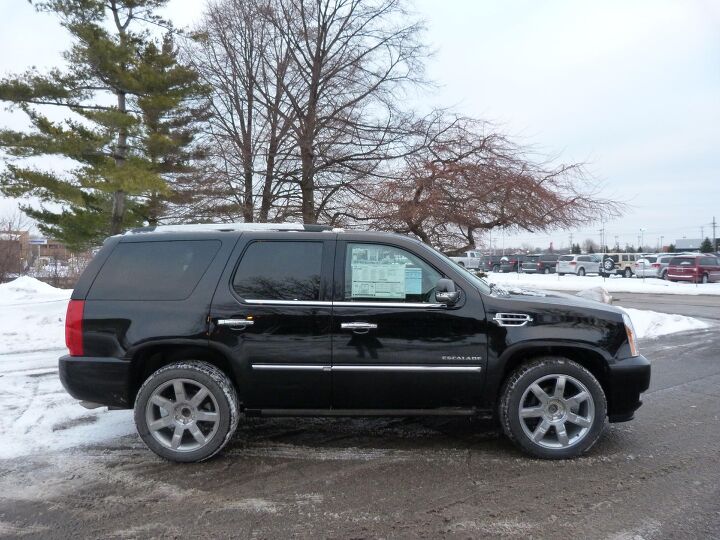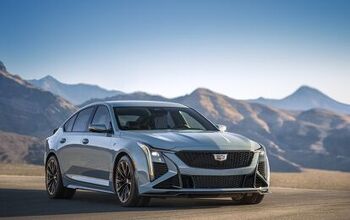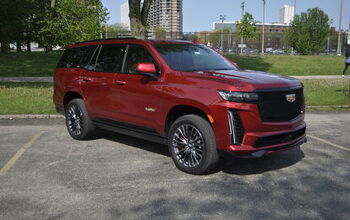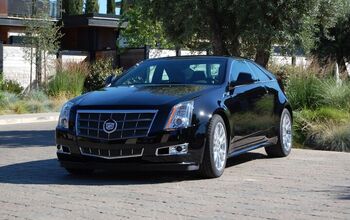Review: 2011 Cadillac Escalade
A large luxury SUV can’t be expected to make rational sense. As readers pointed out when commenting on Wednesday’s Lincoln Navigator review, anyone who needs the combination of interior space and towing capability the Navigator and its arch-rival, the Cadillac Escalade, have on offer, could obtain the same functionality in a Ford Expedition or Chevrolet Tahoe / Suburban for a lot less money. For the Lincoln and Cadillac to be worth their loftier prices, they’d better deliver something above and beyond mere functionality. The Lincoln fell short in this regard, coming across as little more than a bechromed Ford. Might the Cadillac Escalade fare better?
Like the Navigator, the current Escalade is now in its fifth model year. So it’s not fresh. But the Cadillac’s more chiseled lines have aged better and it gets by with a more restrained application of chrome trim.
The grille is huge, but artfully shaped. It is not out of proportion given the size of the vehicle and faithfully advertises the power lurking within. The 22-inch-alloys (with center caps awaiting PDI) are out of proportion to the size of the vehicle, at least the regular wheelbase variant I tested. The double dubs better suit the extended wheelbase Escalade ESV. From the rear there’s little to distinguish the Escalade from the closely related Chevrolet and GMC SUVs. It could be worse: Cadillac’s designers could have drawn inspiration from the Family Truckster the way the designers of the first-generation Navigator did.
This generation of Escalade received a bespoke instrument panel. The styling is sufficiently premium and the switchgear, if not quite up to the $75,000 MSRP, comes closer than that in the Navigator. The Cadillac isn’t embarrassingly pedestrian inside.
The front seats could be better. Though blessed with power four-way lumbar adjustments, their convex contour provides no lateral support. They also feel a little undersized and unworthy of the vehicle they occupy. The Lincoln’s thrones are much larger and cushier. Visibility also isn’t quite as good in the Cadillac, as the base of the windshield is higher. But we are talking about the difference between very good and outstanding. As in the Lincoln there’s nowhere for the driver to properly rest a left foot. The only solution: rest it flat on the floor. While this might seem natural at the dinner table, it takes some getting used when driving a vehicle. The shifter is on the column rather than on the console, which makes operating the “tap up, tap down” rocker somewhat awkward. Since the rocker will be of most use in mountain driving, and even there only occasionally, this isn’t a deal breaker.
The second row is, like the first, undersized compared to that in the Lincoln. The third row, well, it’s simply ridiculous. The Escalade continues to employ a live rear axle, and this forces a high rear floor. So the third-row seat cushion is pretty much right on the floor. Adults sitting back might have enough headroom (if they’re under six feet), but they’ll find their knees above their elbows. The Navigator has a huge advantage here. Stepping up to the ESV only partially addresses the shortfall.
Cargo room is similarly impacted. There’s little of it behind the third-row seat. Adding injury to insult, the third row doesn’t fold to form a flat floor and must be removed to provide a competitive amount of cargo room. The Navigator is a much more functional vehicle. So are GM’s large “Lambda” crossovers, for that matter. (Rumor has it that the next Escalade will be Lambda-based.)
But, remember, this class of vehicle isn’t about functionality. Dip into the throttle, and the Escalade starts to make sense. The 6.2-liter V8 kicks out 403 horsepower at 5,700 rpm and 417 pound-feet of torque at 4,300 rpm. And these numbers aren’t the half of it. Even with so much power the Escalade isn’t a rocket ship—there’s too much mass for that. Where it really redeems itself is in how it sounds and feels. Even if acceleration isn’t shockingly quick, it is effortless. Unlike the Lincoln’s V8 this one never seems like its straining. It never had to jump down two or three ratios and then issue forth an unseemly roar. Not that the Escalade’s V8 is quiet; far from it. The big small block roars at full throttle, and audibly burbles much of the rest of the time. Some people might find this noise tiresome, but they won’t be interested in an Escalade anyway. The V8’s burble recalls fine watercraft more than anything on wheels, and in the process makes driving the Escalade a distinctive, and distinctively American, experience. For something to be a guilty pleasure it must be pleasurable, and prodding this powerplant is pleasurable.
On center the Escalade’s steering feels far too light and a touch loose. But helm the ute into a curve and effort builds naturally. Feedback through the seat of the pants is reassuring; the big SUV willingly goes where it’s pointed. Though certainly not predisposed to hoonery, give the Escalade your spurs and it responds “sure, why not?” In this mode a more conveniently located transmission control would be welcome. Compared to the Lincoln, the Cadillac flows with the road rather than fighting it. Even with its lower profile 285/45R22 tires the Escalade rides much more smoothly than its closest competitor. There’s no sense of the body shimmying atop its mounts. The standard “magnetic ride control” shocks that alter their firmness up to 1,000 times a second no doubt deserve some of the credit. But trick shocks can only do so much. GM seems to have put far more effort than Ford into suspension and body tuning. Despite its live rear axle and overboosted steering, the Escalade both rides and handles much better than the Navigator.
Cadillac, apparently aware of its vehicle’s more premium feel, charges heftily for it. Though the two vehicles I drove were comparably equipped, with an MSRP of $75,000 the Escalade listed for $12,000 more than the Navigator. Add another $3,200 for the extended wheelbase ESV (recommended). Running the pair through TrueDelta’s car price comparison tool finds that features account for only a few hundred dollars of this price difference. After this adjustment the Lincoln’s price advantage remains over $11,000. Oddly enough, the Chevrolet Tahoe LTZ (with a 5.3-liter V8 and 20s) also checks in about $11,000 below the Cadillac.
I’m not about to attempt a rational defense of the Cadillac Escalade. Cadillac has never marketed itself as a sensible purchase. Instead, it has always been an aspirational purchase, and an experience. With its size, its brash yet tastefully handsome styling, and its stonkin V8, the Escalade delivers what buyers in this segment are looking for. Driving it is a much different experience than driving a sports car or a high-end sedan, but it’s a rewarding experience nonetheless. Though not a place I’d care to live, I thoroughly enjoyed the visit.
Eric Breda at Cadillac of Novi provided the test vehicle. Eric can be reached at 248-476-4466.
Michael Karesh operates TrueDelta, an online source of car pricing and reliability data.
Michael Karesh lives in West Bloomfield, Michigan, with his wife and three children. In 2003 he received a Ph.D. from the University of Chicago. While in Chicago he worked at the National Opinion Research Center, a leader in the field of survey research. For his doctoral thesis, he spent a year-and-a-half inside an automaker studying how and how well it understood consumers when developing new products. While pursuing the degree he taught consumer behavior and product development at Oakland University. Since 1999, he has contributed auto reviews to Epinions, where he is currently one of two people in charge of the autos section. Since earning the degree he has continued to care for his children (school, gymnastics, tae-kwan-do...) and write reviews for Epinions and, more recently, The Truth About Cars while developing TrueDelta, a vehicle reliability and price comparison site.
More by Michael Karesh
Latest Car Reviews
Read moreLatest Product Reviews
Read moreRecent Comments
- Varezhka I have still yet to see a Malibu on the road that didn't have a rental sticker. So yeah, GM probably lost money on every one they sold but kept it to boost their CAFE numbers.I'm personally happy that I no longer have to dread being "upgraded" to a Maxima or a Malibu anymore. And thankfully Altima is also on its way out.
- Tassos Under incompetent, affirmative action hire Mary Barra, GM has been shooting itself in the foot on a daily basis.Whether the Malibu cancellation has been one of these shootings is NOT obvious at all.GM should be run as a PROFITABLE BUSINESS and NOT as an outfit that satisfies everybody and his mother in law's pet preferences.IF the Malibu was UNPROFITABLE, it SHOULD be canceled.More generally, if its SEGMENT is Unprofitable, and HALF the makers cancel their midsize sedans, not only will it lead to the SURVIVAL OF THE FITTEST ones, but the survivors will obviously be more profitable if the LOSERS were kept being produced and the SMALL PIE of midsize sedans would yield slim pickings for every participant.SO NO, I APPROVE of the demise of the unprofitable Malibu, and hope Nissan does the same to the Altima, Hyundai with the SOnata, Mazda with the Mazda 6, and as many others as it takes to make the REMAINING players, like the Excellent, sporty Accord and the Bulletproof Reliable, cheap to maintain CAMRY, more profitable and affordable.
- GregLocock Car companies can only really sell cars that people who are new car buyers will pay a profitable price for. As it turns out fewer and fewer new car buyers want sedans. Large sedans can be nice to drive, certainly, but the number of new car buyers (the only ones that matter in this discussion) are prepared to sacrifice steering and handling for more obvious things like passenger and cargo space, or even some attempt at off roading. We know US new car buyers don't really care about handling because they fell for FWD in large cars.
- Slavuta Why is everybody sweating? Like sedans? - go buy one. Better - 2. Let CRV/RAV rust on the dealer lot. I have 3 sedans on the driveway. My neighbor - 2. Neighbors on each of our other side - 8 SUVs.
- Theflyersfan With sedans, especially, I wonder how many of those sales are to rental fleets. With the exception of the Civic and Accord, there are still rows of sedans mixed in with the RAV4s at every airport rental lot. I doubt the breakdown in sales is publicly published, so who knows... GM isn't out of the sedan business - Cadillac exists and I can't believe I'm typing this but they are actually decent - and I think they are making a huge mistake, especially if there's an extended oil price hike (cough...Iran...cough) and people want smaller and hybrids. But if one is only tied to the quarterly shareholder reports and not trends and the big picture, bad decisions like this get made.









































Comments
Join the conversation
No, no. Cadillac did at one time - I'm recalling this in ads for the nearly insane '59 - market itself as "surprisingly economical". It was clever marketing: emphasize that the basic car, the Series 62, was a sensible, well-engineered and economical machine. It only added to the allure of the lavish de Ville cars.
There's a sucker born every minute. Only toolbags with small wieners need apply. All it needs is a nice, large set of brass testicles hanging off its rearend!